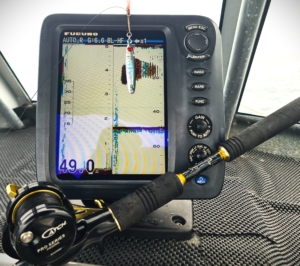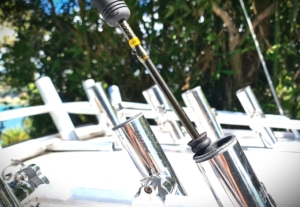Awesome autumn – a single weekend of summer left, then autumn arrives! Some very good things fishing-wise happen in autumn…
Hauraki Gulf, and fishing.
The full moon late last week really dampened the snapper bite, threw out the anchor even – with a few days of scratching heads wondering what the fish are up to, with oh-so-tentative barely detectable bites much of the time. Fortunately just a few days later the bite has returned somewhat better. The Firth of Thames has been doing alright – great with the easterlies as it’s a bit more sheltered than out in the open gulf, and with both snapper and kingfish it’s a good place to be fishing right now. Out in the open areas of the gulf, like east of the cable zone in 40-45m chart depth has seen a steady pannie brigade hard on the sea floor. The technique of gradually, slow jig style, retrieving your lure up 10 winds is an effective method for these snapper with their ‘yeah-nah’ attitude – whether using the slow jigs like Beady Eye Kabura , or those devastating micro jigs imitating anchovies like the Pocket Rockets, worth their weight in tungsten. Sporadic smaller workups dotted around the area, with dolphins a bit lazy on it has been similar to the snapper bite overall, fits and starts.
However we are now past the full moon influence, and even though it is high summer temps in the water, fishing is relatively good. Expect a few ‘Kabura-days’ i.e. slow and steady wins the race but the amp will be slowly turned up for the autumn snapper fishing. Lots of good looking anchovy schools hanging around mid water out in 40-50m and some showing themselves closer, in 20m out from North Shore Bays in the early evenings this week for instance. The mid-water hangout in deeper water is a strategy anchovies have to help avoid predator attacks – avoiding the surface barrier, and bottom dwelling predation.

Figure 1. Pocket Rocket poised to drop through anchovies – perfect!
So if you’re out in the gulf, and the gannets or other sea birds are just sitting around, even in small groups, often just preening or waiting, check your sounder there’ll probably be a big bait-school under or near them. So what would you drop down? Anchovy look-a-likes for sure even if you can’t see much on the floor in terms of snapper on your sounder. Microjigs with silver, imitating shiny anchovy are perfect – like the infamous Pocket Rocket with it’s bleeding eye. In terms of softbaiting a smaller approach would be good to start with. The Black Label LIVIES 5” on a jighead works a treat. Do try the slow steady retrieve with all your lures at the moment, it seems to be the extra trick to get snapper biting, and surprisingly they will follow and tag at your lure a long way up. Try not striking as well, let the fish hook itself as you tease it’s lunch snack slowly away from it. Also the normal vertical approach to lures…mix it up with letting your boat drift and the lure out well behind, occasionally letting line out but fishing more on the angle, a struggling anchovy that can’t get back up is a prime food target. And if you’re out Little Barrier way – good snapper fishing, around the edges in just 10-20m, softbait territory for some excellent snapper.
Bad Habits:
Your trusted hunting companion, through thick and thin – one of the most important components of your fishing tackle – your rod, and the one that probably gets the least amount of care and attention, abuse even – like putting your hook through a guide to hold it!
The hook shaft or the barb will grind against the guide, especially if you’re underway on a boat, kayak ski etc, and yes this can chafe your guide, or pop the inner – out. Use the hook holder on your rod. No hook holder? A zip-tie with a solid or split ring is a lot better than using those beautiful made from unobtainium-coated guides you’ve paid for.
Wash down with a spray of fresh water, a quick spray of silicon (watch out for too much on the grips, or avoid them), any ‘tea-stain’ (euphemism for rust) on metal parts of guides, just gently rub off with a used pot scrubber, car cut ‘n polish, metal polish (Brasso, Autosol) or even a fingernail…gently so as not to damage and scratch the guide, then spray with silicon. While you’re at it, have a close look (use a magnifying glass if you or the kids have one – like you used to burn holes in newspaper with the sun) to inspect the inner edge of each guide. Look for any scratch, nick or imperfection – if there is, get the guide fixed. Otherwise your line will wear as a result, and right along it’s length, making for unpredictable and random ‘bust-offs’ you blame on the fish, a reef, the braid manufacturer, Poseidon himself – everything but the actual cause, you and your rod guide. The guide was probably damaged when you/me carelessly in a hurry – I know you wouldn’t do it on purpose – putting your hook through a guide to hold it. Run your finger lightly around the inside of the guide, oh so gently – you can pick up surprisingly small cracks and chips by doing this. NOT CHECKING YOUR GUIDES? Ah next time, round-2-it, hasn’t affected me so far…no worries? Better off to wait until you’ve latched onto that personal best, a big beauty of a 20lb snapper, a 30kg kingfish, an incredibly tasty bluenose, marlin, tuna – whatever you happen to hook up yeah? Nah. It’s too late to check and fix the next time you go fishing, it must be done beforehand, today is good.
Bare butt? Foam rubber protectors come with slow pitch rods like the Kensei shown, but some rods don’t, unfortunately this means that time in the rod holder while underway means damage and broken rods.

Figure 2 Simple rod holder protection, avoids the inevitable…
Use a little rubber bumper – like the one pictured, or make one yourself, zip tying on firmly means you can slide it up and down to cater for different rod holder lengths easily. It does not take much of a rattle to damage the fine carbon fibre – once damaged it is significantly weakened. Even spiral cable tidies work…cut a bit off around the back of your computer (assuming the OCD in the office has tidied cables up) and wind onto the rod shaft.
Wraps help immensely too (one of my top 5 picks of tackle accessories to have onboard), stopping your jig or lure bashing against your high carbon rod, certain death sooner or later to your pride and joy. Fast, cheap, buoyant – use for jig/lures, securing rods together avoiding damage and many tip-breaks while transporting…just another little thing that makes a big difference to your enjoyment of fishing particularly long term, it’s often the small things that help put that big smile on your dial.
Gt. Barrier closures – the anchoring and fishing restrictions are is still in place, Whangaparapara, Tryphena and Blind Bay. Caulerpa brachypus: a non-native seaweed. The non-native seaweed has been found in Blind Bay, Tryphena Harbour and Whangaparapara Harbour on Great Barrier Island. This seaweed can spread rapidly and could affect native species.To minimise the spread of Caulerpa brachypus, Biosecurity New Zealand placed a Controlled Area Notice (CAN) on Blind Bay and Tryphena Harbour, effective from Monday, 20 September 2021. The CAN and rāhui are in place until 30 June 2022. Maps of the Controlled Areas:
Caulerpa Controlled Area Notice: Zone A – Tryphena Harbour, Great Barrier Island
Caulerpa Controlled Area Notice: Zone B – Blind Bay, Great Barrier Island
Caulerpa Controlled Area Notice: Zone C – Whangaparapara Harbour, Great Barrier Island
Pilot whales have been cruising past southern by Gt Barrier, always a delightful oddity, not great for fishing around though, unlike the big beautiful Brydes whales. Change is constant, and the season’s change to Autumn is very welcome for fishing. Bring it on, and enjoy being out there doing it!
Questions about your gear, technique, what lures? Message me, only too happy to help.
Cheers






